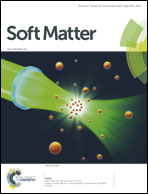Free energy of binding of cationic metal complexes to AuNPs through electron-transfer processes
Abstract
AuNP effects on the oxidation reaction of [Ru(NH3)5pz]2+ with S2O82− were studied. Experimental results show the effects produced by gold nanoparticles of different sizes, which are then discussed by using an approach based on the two-state model. Changes in the observed reactivity are explained by a change in the degree of association of the reactants to the nanoclusters, which depends on the negative surface potential of the gold nanoparticles. TEM and zeta potential measurements show that this potential determines the binding strength of one of the reactants ([Ru(NH3)5pz]2+) to the citrate gold surface. The number of binding sites on a citrate nanoparticle receptor has also been determined. The experimental results confirm that an electron transfer reaction can be used as a probe for the determination of the free energy of binding of cationic metal complexes to gold nanoparticles.


 Please wait while we load your content...
Please wait while we load your content...